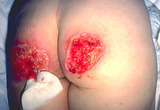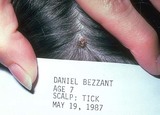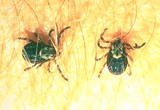The Health Education Assets Library (HEAL) is a collection of over 22,000 freely available digital materials for health sciences education. The collection is now housed at the University of Utah J. Willard Marriott Digital Library.
TO
Filters: Collection: "ehsl_heal"
| Title | Description | Subject | Collection | ||
|---|---|---|---|---|---|
| 301 |
 |
Suturing | The second throw is made by placing the needle holder in the inside of the long arm (needle bearing) of the V, and | Knowledge Weavers Dermatology | |
| 302 |
 |
Suturing | The needle holder is then placed on the inside of the long arm (needle bearing end) of the V, and a single loop is thrown around the needle holder. The short end of the suture is then grasped, and | Knowledge Weavers Dermatology | |
| 303 |
 |
Tearing action | They are then opened which creates a tearing action. | Knowledge Weavers Dermatology | |
| 304 |
 |
Thermal burn | This patient received a thermal burn to the buttocks, and there was complete destruction of the skin and some of the underlying fat. This shows the exposed fat after I debrided the necrotic skin. Normal fat appears yellow. | Knowledge Weavers Dermatology | |
| 305 |
 |
Thickness biopsy | One of the typical lesions is anesthetized, and then a 4 mm diameter punch of the full thickness skin is done. The skin in most areas is 2 mm in depth, and 4 mm on the back. The wound is then closed with 4-0 monofilament suture using a vertical mattress closure, and one or two sutures are placed. | Knowledge Weavers Dermatology | |
| 306 |
 |
Thickness biopsy | When a patient has an eruption and the diagnosis is unknown, it is best to do a full thickness biopsy by doing a punch or small excision of one of the lesions. | Knowledge Weavers Dermatology | |
| 307 |
 |
Ticks | The maximum incubation period for the tick-borne diseases seen in Utah would be seven days. If you were asked by someone who has had a tick how long they have to wait before they are out of the woods (so to speak), the answer is one week. | Knowledge Weavers Dermatology | |
| 308 |
 |
Ticks | The most common tick-borne disease in this area is Colorado Tick Fever, and second would be Rocky Mountain Spotted Fever, and rarely Tick Paralysis. The organism that causes Lyme disease (Borrelia burgdorferi) has not been shown to be carried by ticks in Utah. | Knowledge Weavers Dermatology | |
| 309 |
 |
Topical acne therapy | The first few weeks of topical acne therapy can be accompanied by redness and flaking of the skin. Lubricants will help to control scaling, and if necessary, one can add 1% hydrocortisone lotion or cream twice daily to help to reduce the inflammation. | Drug Effects | Knowledge Weavers Dermatology |
| 310 |
 |
Treating mild acne | This demonstrates two approaches to treating mild acne (comedos and less than about 10 red papules and pustules). The first treatment is shown on the left,and she applies Cleocin-T lotion to her face each morning, and Cleocin-T lotion and Retin-A 0.025% cream to her face each evening. A second alter... | Drug Effects | Knowledge Weavers Dermatology |
| 311 |
 |
Treatment for rosacea | . . . to take 500 mg of tetracycline at night. | Knowledge Weavers Dermatology | |
| 312 |
 |
Treatment for rosacea | The alternative to tetracycline is minocycline, 100 mg twice daily, and it has the advantage that it can be taken with food, including dairy products, and rarely causes photosensitization. The disadvantage is that it is much more expensive than tetracycline, and it currently costs about $1.00 to $3.... | Knowledge Weavers Dermatology | |
| 313 |
 |
Treatment for rosacea | Typical treatment for rosacea is to take 500 mg of tetracycline in the morning, and . . . | Knowledge Weavers Dermatology | |
| 314 |
 |
Treatment of comedonal acne | Retin-A 0.025% cream. It is recommended that a person wait 20 to 30 minutes after washing the face before applying Retin-A, but I find that it is very difficult for people to remember to do that, and it markedly reduces the compliance. I recommend that they simply apply the medication immediately af... | Retin-A | Knowledge Weavers Dermatology |
| 315 |
 |
Treatment of comedonal acne | When a patient has comedos along with less than about 15 red papules and pustules, one can use the regimen shown either on the patient's left or the patient's right. The method I usually use is shown on the patient's right: The patient is to apply benzoyl peroxide 2.5% gel to the face q am, and Reti... | Knowledge Weavers Dermatology | |
| 316 |
 |
Treatment of Scabies | Treatment of choice for scabies is to apply permethrin (Elimite) overnight from the neck down, and to ensure that everyone in the patient's family be treated at the same time. The bedding and clothing from the past week should be washed or dry cleaned, or it can be placed in a plastic bag and set as... | Knowledge Weavers Dermatology | |
| 317 |
 |
Trendelenburg position | In anaphylaxis the patient should be placed in the head down (Trendelenburg) position. | Knowledge Weavers Dermatology | |
| 318 |
 |
Undermining | The edges of the wound should pull together easily; if not, undermining needs to be done. Undermining means cutting the fibrous septae that connect the skin to the underlying fascia, and generally this is accomplished by using the scalpel to cut the septi just beneath the dermis as shown here. Under... | Knowledge Weavers Dermatology | |
| 319 |
 |
Undermining with scalpel | This demonstrates undermining with a scalpel just beneath the dermis. | Surgical Methods | Knowledge Weavers Dermatology |
| 320 |
 |
Undermining with scalpel | This demonstrates undermining of the dermis using a scalpel. | Knowledge Weavers Dermatology | |
| 321 |
 |
Undermining with scissors | This demonstrates undermining with scissors. The closed jaws are inserted beneath the dermis, and | Knowledge Weavers Dermatology | |
| 322 |
 |
Urticaria | This patient has developed rather severe urticaria, the cause of which was unknown. In urticaria, the skin swells and initially looks red and later can blanch as the amount of fluid increases within the skin. Internal organs can be involved in the process, and we are particularly concerned about the... | Knowledge Weavers Dermatology | |
| 323 |
 |
Urticaria | Urticaria | Knowledge Weavers Dermatology | |
| 324 |
 |
Urticaria wheal | The appearance of typical urticaria wheal. | Knowledge Weavers Dermatology | |
| 325 |
 |
Vasculitis | More severe damage to capillary sized vessels allows a significant amount of red blood cells and fluid to leak into the surrounding dermis, and this condition is called vasculitis. This is small vessel (capillary) vasculitis. | Knowledge Weavers Dermatology |
